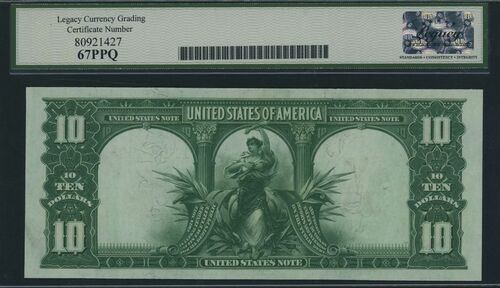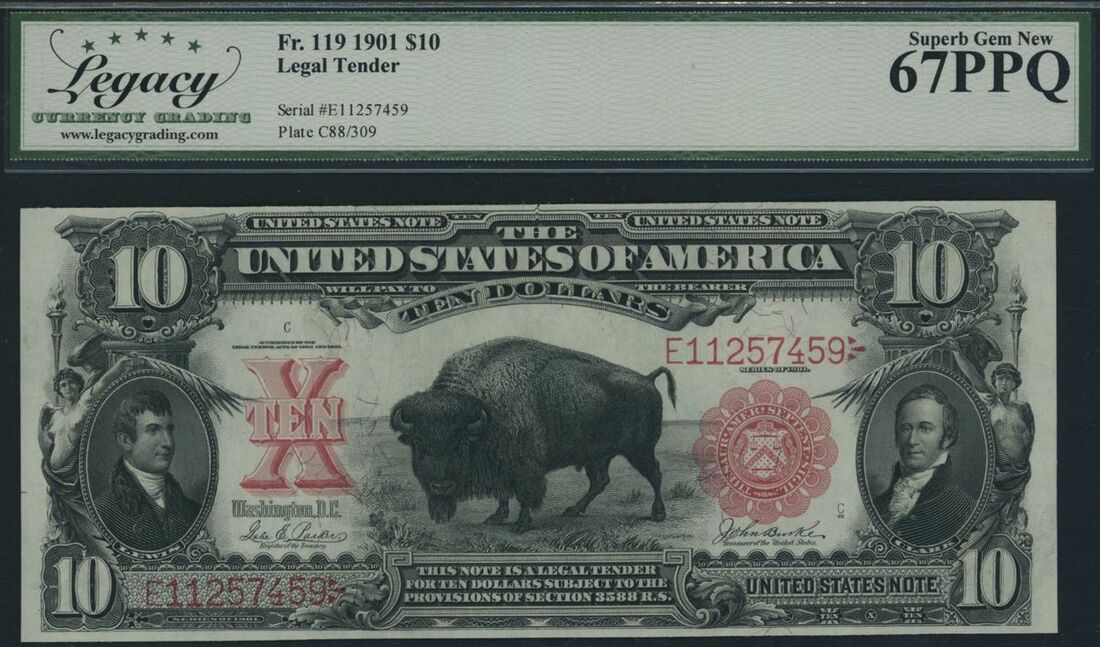Auction: 24009 - World Banknotes
Lot: 466
(x) Unites States of America, 10 Dollars, 1901, Washington D.C., serial number E11257459, Plate C88/309,
this $10 Bison Note, officially known as the Series of 1901 $10 Legal Tender Note, is one of the most iconic pieces of American currency.
Issued in 1901, it features a unique and intricate design that has made it a favourite among collectors. The front of the note prominently displays an American bison, symbolising the nation's wildlife and the spirit of the American West. This bison image was based on a stuffed specimen displayed at the Smithsonian Institution in Washington, D.C., which had been preserved after being killed in the Montana Territory in 1886.
Flanking the bison are portraits of Meriwether Lewis and William Clark, the famous explorers who led the early 19th-century Lewis and Clark Expedition. Their journey was pivotal in exploring the western territories of the United States. The reverse of the note features an allegorical figure known as "Columbia," representing the United States with classical symbols of freedom and liberty.
At the time of the note's issuance, the American bison population had drastically declined due to overhunting and habitat loss. By featuring the bison, the note highlighted this majestic creature and subtly promoted conservation efforts. The decision to include the bison symbolised the opening of the American West, an era marked by exploration and expansion.
In 1901, the United States was seeking to strengthen its national identity through its currency by incorporating iconic American symbols and historical figures. The nation, with President William McKinley in office, consisted of 45 states, and the average annual salary for an American male was $450.
This Bison Note was a type of Legal Tender note, first issued in 1861, backed by the "full faith and credit of the United States government" rather than gold or silver. These notes were required to be accepted as payment for all debts, public or private.
The Bureau of Engraving and Printing (BEP) had refined their engraving skills by the early 20th century, producing some of the most artistically impressive notes ever seen. The decision to feature the bison as the central image was influenced by its powerful symbolism of the American frontier. Contrary to popular belief, the bison depicted on this note is not "Black Diamond," the bison from the 1913 Buffalo Nickel, which resided at the Bronx Zoo.
The same bison image of this note, later appeared on a 30-cent postage stamp in 1923 and on a Military Payment Certificate during the Vietnam War era.
Despite being worth more than a week's salary for the average American at the time, the note's popularity was driven by its iconic imagery, much like the Buffalo Nickel that followed a dozen years later.
This historic note, blending artistry, history, and cultural significance, is a prized item in large size currency collections. It represents not just a piece of currency but a symbol of America's past, its natural beauty, and the enduring legacy of its explorers and pioneers.
(Fr. 119), in Legacy Currency Grading holder 67 PPQ Superb Gem New
Subject to 5% tax on Hammer Price in addition to 20% VAT on Buyer’s Premium.
Estimate
£14,000 to £20,000







